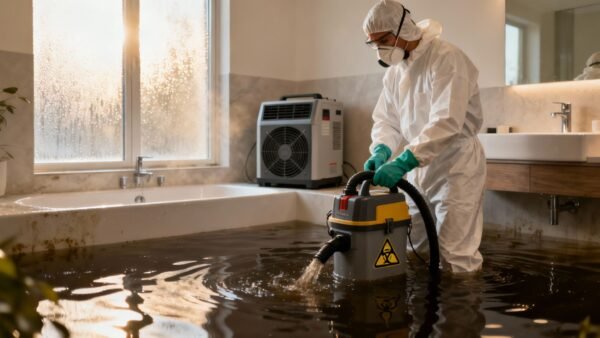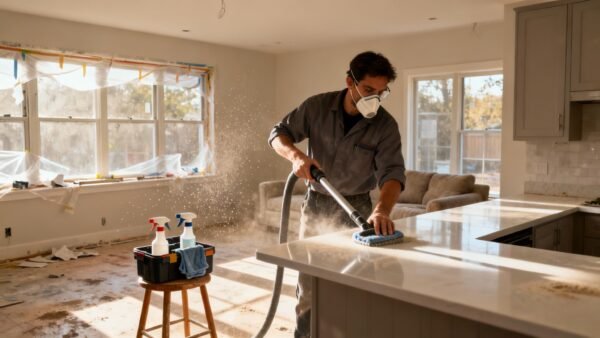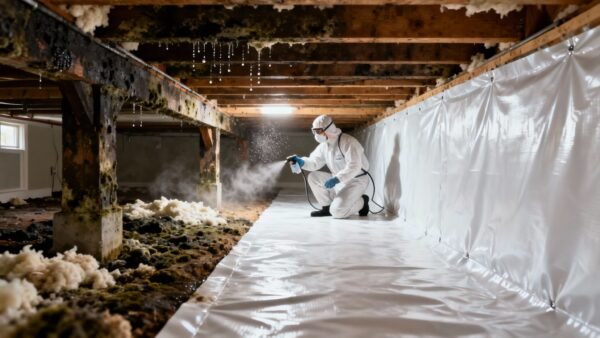That musty smell in your Sherman Oaks basement or the discolored patch behind a leaky pipe in your Santa Monica home is your property sending up a flare. When you find yourself searching for “mold testing and removal near me,” what you’re really asking is a critical question: Can I handle this myself, or is it time to call in the professionals? For Los Angeles homeowners, understanding the difference is key to protecting both your property’s value and your family’s health.
This guide breaks down everything from identifying the problem to choosing the right local experts for mold testing and removal.
The Hidden Dangers of Indoor Mold
Discovering mold is a bit like spotting the tip of an iceberg. What you see on the surface is often just a small clue to a much larger, hidden problem lurking within your walls, floors, or ceilings.
Sure, a tiny spot of mildew on a shower tile is one thing. But when you have significant or recurring growth, it’s a clear sign of a deeper moisture issue—like a flat-roof leak common in older homes—that DIY sprays and scrubs just won’t fix. It’s not a mess; it’s a warning signal.
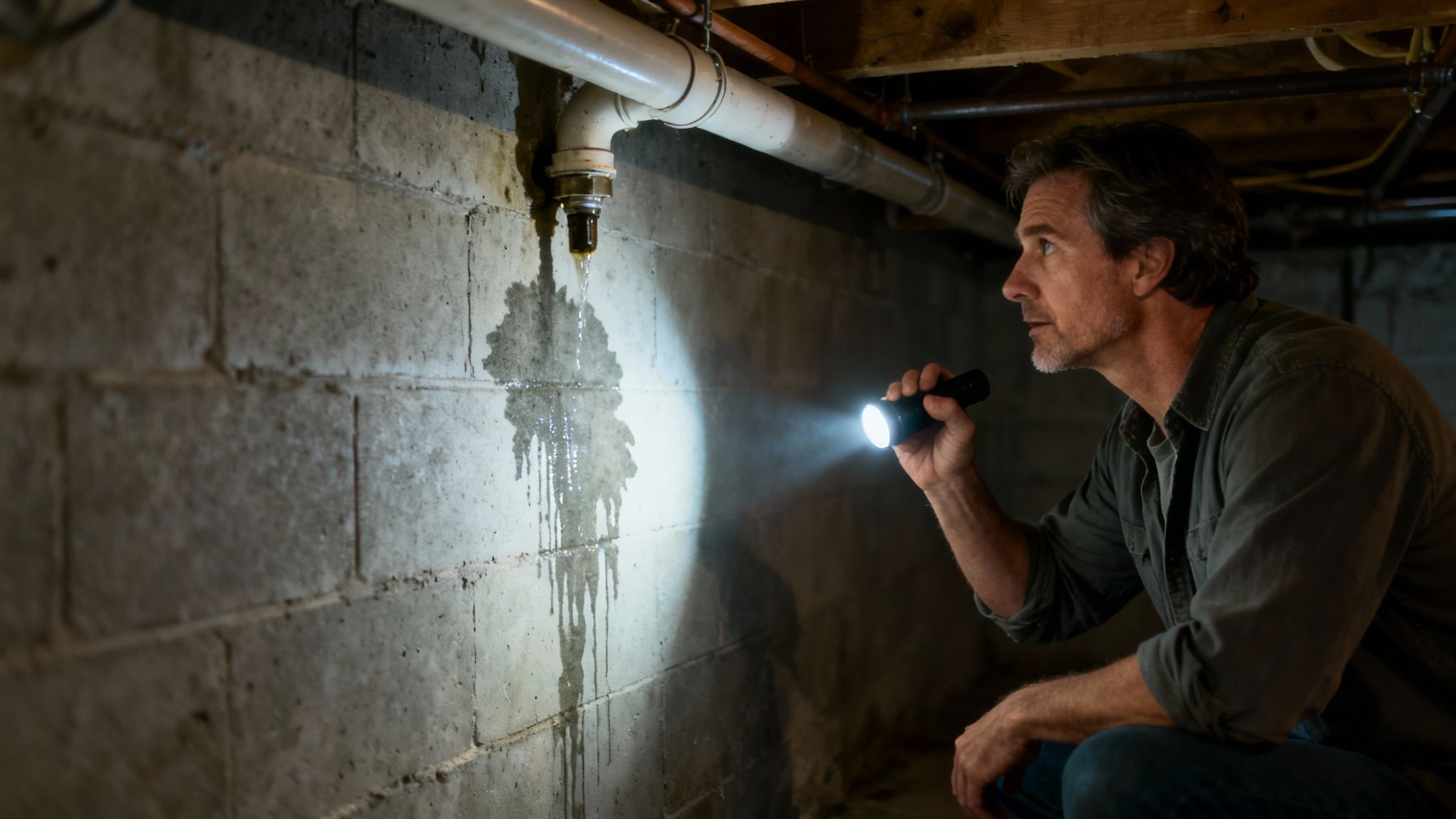
This isn’t just about looks, either. Unchecked mold is destructive. It literally eats away at organic materials like drywall, wood framing, and insulation, slowly compromising your home’s structural integrity. More importantly, it pumps microscopic spores into the air you breathe, creating a serious potential health hazard for you and your family.
Health Risks Linked to Mold Exposure
Knowing when to bring in an expert for mold testing and removal is crucial. It’s the difference between putting a band-aid on a small cut and heading to the doctor for a wound that needs stitches.
Here’s a quick rundown of the most common signs that you need a professional mold inspection.
Quick Guide to Common Mold Warning Signs
This table helps you quickly connect a symptom in your home to what it might mean and the best next step.
| Symptom or Sign | What It Could Mean | Recommended Action |
|---|---|---|
| Persistent Musty Odor | There’s likely hidden mold growth inside walls, under floors, or in the HVAC system. | Call for a professional inspection, as the source is probably not visible. |
| Visible Discoloration | You have active mold growth. The size of the visible patch may not reflect the full extent. | Avoid touching or spraying it with bleach. Contact a remediation specialist to assess the scope of the problem. |
| Recent Water Damage | Mold can start growing in just 24-48 hours after a leak, flood, or burst pipe. | Even if you cleaned up the water, schedule a moisture inspection to ensure the area is truly dry. |
| Unexplained Health Symptoms | Airborne mold spores could be triggering allergies, respiratory issues, or headaches. | Consult with a professional to test your indoor air quality and identify potential mold sources. |
If you’re noticing one or more of these signs, it’s a strong indicator that the problem has moved beyond a simple DIY fix.
The Growing Demand for Professional Mold Testing
More and more homeowners are waking up to these dangers, and it shows. The global market for professional mold testing services was valued at around $1.5 billion in 2023 and is on track to nearly double by 2032.
This surge is driven by a simple fact: people are more aware of the health risks and understand that a professional diagnosis is the only way to be sure their home is safe. You can read the full research about mold testing market growth to see why expert assessment is quickly becoming the standard for any responsible homeowner.
How to Tell if You Need Professional Remediation
Think of a professional mold inspection less like a check-up and more like a crime scene investigation for your home. The inspector isn’t just there to spot visible mold; they’re a detective, piecing together clues to understand the full story of what’s happening inside your walls. When you’re searching for mold testing and removal near me, this is the critical first step that separates a wild guess from an accurate diagnosis.
This process is all about uncovering the “why” behind the problem—the hidden moisture source that’s feeding the growth. A certified inspector arrives not just to confirm what you can see, but to find what you can’t.
The Initial Visual Assessment
The investigation always starts with a thorough visual sweep. Your inspector will walk through the property, room by room, focusing on areas notorious for moisture. This means basements, crawlspaces, attics, and anywhere with plumbing, like kitchens and bathrooms.
They’re trained to spot the subtle signs of water damage that most homeowners miss: slight discoloration on drywall, paint that’s just starting to peel, warped baseboards, or that faint, musty smell you might have gotten used to. This walkthrough is essential for flagging potential “hot spots” that need a closer look.
A professional assessment is so important because what’s visible is often just the tip of the iceberg. Mold colonies love to grow behind walls and under floors, silently releasing spores into the air without any obvious signs.
Gathering Evidence with Specialized Tools
After the initial sweep, the detective work gets more technical. Just like a forensics team, inspectors use specialized tools to gather hard evidence.
- Moisture Meters: These devices measure the moisture content inside building materials like drywall and wood. A high reading can pinpoint a hidden leak or a pocket of dampness that’s fueling mold growth.
- Infrared (Thermal) Cameras: This is the cool part. This technology lets inspectors “see” temperature differences behind your walls. Wet spots are usually cooler, showing up as distinct patterns on the camera’s screen and revealing potential water intrusion without having to break anything open.
These tools give us a non-invasive way to map out the extent of the moisture problem, which tells us a lot about the potential scope of the mold contamination.
Air and Surface Sampling: The Lab Analysis
The most definitive part of the inspection is collecting samples for lab analysis. This is where the inspector gathers the final pieces of the puzzle to confirm exactly what type of mold you’re dealing with and how much of it is in your home. There are two main ways we do this.
1. Air Sampling: The inspector uses a special pump that draws a precise amount of air through a collection cassette. This sample traps any airborne spores—visible or not—giving us a clear picture of your indoor air quality. It’s especially useful for sniffing out hidden mold that isn’t visually obvious.
2. Surface Sampling: If there’s visible growth, the inspector might use a sterile swab or a special tape lift to collect a direct sample. This helps identify the specific mold species growing in that spot.
These samples get sent off to an accredited, third-party lab. The report that comes back is the final verdict, detailing the types of mold found and the concentration of spores in your air. This data is the foundation for creating an effective, targeted remediation plan. Armed with this information, you can be an informed partner in the process of getting your home healthy again.
Your Guide to the Professional Mold Remediation Process
Once a professional mold inspection confirms you have a problem, the real work begins. This is the mold remediation phase—a highly controlled process that’s far more like a surgical procedure for your home than a simple cleaning job. When you search for mold testing and removal near me, this is the “removal” part, and it’s where real expertise is absolutely critical.
The goal isn’t just to wipe away what you can see. It’s about systematically eliminating the contamination at its source, clearing the air of invisible spores, and making sure the problem doesn’t come right back. For a Los Angeles homeowner, this might mean fixing persistent dampness from the coastal fog in a Santa Monica beach house or dealing with the aftermath of a burst pipe in a Burbank condo. Every situation demands a methodical, step-by-step approach to get your home back to a safe, healthy state.
Step 1: Containment and Negative Air Pressure
The first and most important step is containment. Think of it like creating a medical cleanroom inside your house. Certified technicians will seal off the entire affected area from the rest of your home using heavy-duty plastic sheeting and tape. This creates an isolated work zone to prevent cross-contamination, ensuring that mold spores kicked up during removal don’t travel through your HVAC system and settle in other rooms.
To take it a step further, the team establishes negative air pressure inside the containment zone. They use specialized machines called air scrubbers, which are fitted with HEPA (High-Efficiency Particulate Air) filters. These powerful units pull air from the contaminated area, trap the microscopic mold spores in the filter, and then vent the clean air outside your home. This creates a gentle vacuum effect, making sure air only flows into the contained area, not out of it, effectively trapping any airborne particles.
This infographic shows just how technicians set up a proper containment zone—the foundation for any safe remediation project.
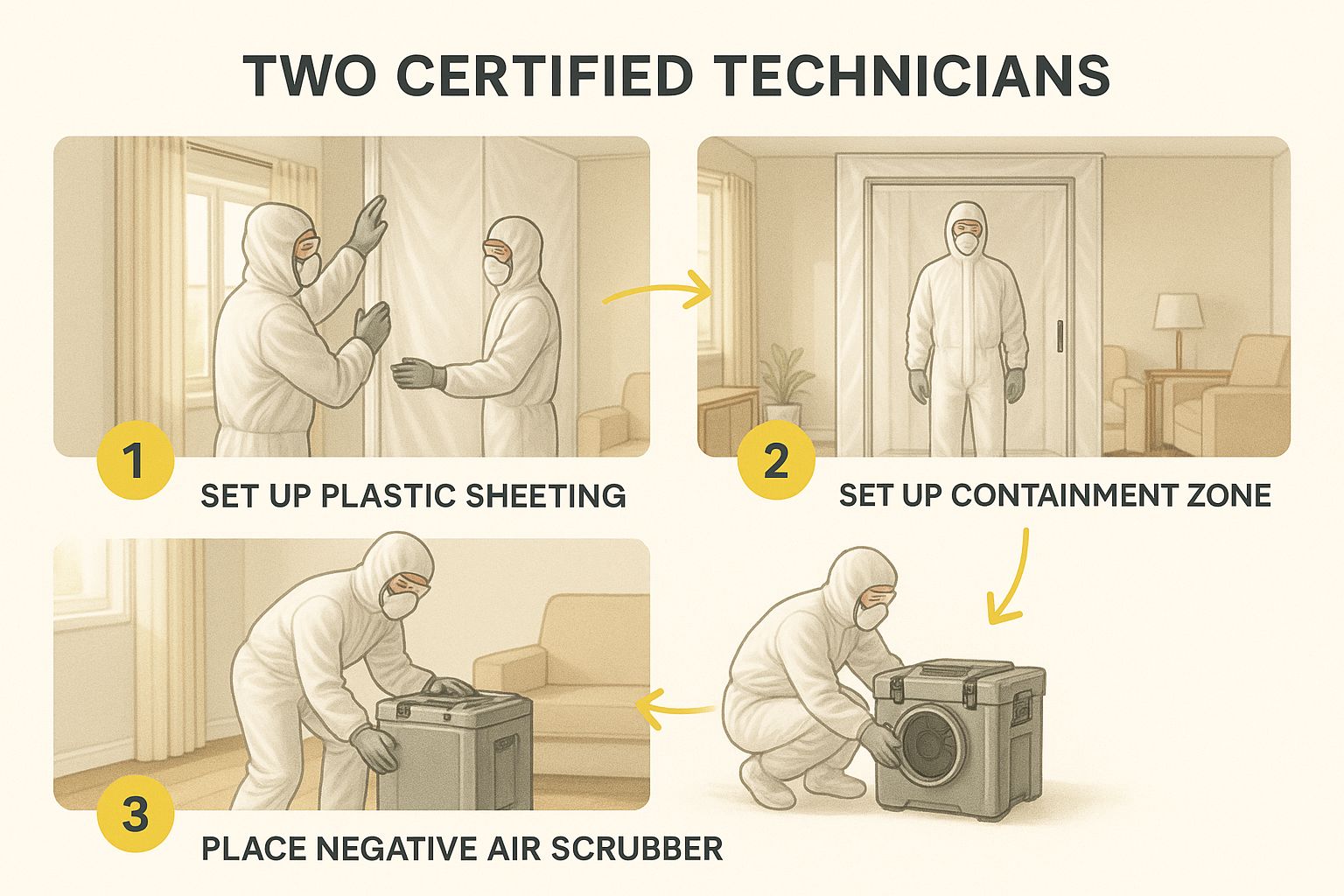
As you can see, it’s a meticulous setup, from the full protective gear to the air filtration systems needed to protect the rest of your property.
Step 2: Removal of Contaminated Materials
With the area safely sealed off, the crew gets to work on the physical removal of anything damaged by mold. Unfortunately, when mold gets into porous materials like drywall, insulation, or carpet, you can’t just clean it. The mold grows root-like structures, called mycelia, deep inside these materials, making it impossible to get rid of completely without tearing it out.
Technicians will carefully cut out and bag all the affected sections in thick, sealed disposal bags, working with precision to minimize the release of spores. Harder, non-porous surfaces like wood framing or concrete can often be saved. These are treated and cleaned using specialized techniques to kill any surface mold.
Step 3: Deep Cleaning and HEPA Vacuuming
After all the contaminated materials are gone, the entire contained area gets a deep, thorough cleaning. This is far beyond your typical housekeeping. Technicians use powerful HEPA vacuums on every single surface—walls, floors, and ceilings—to capture any stray spores that may have settled during the removal process.
Once vacuumed, the surfaces are wiped down with an EPA-registered antimicrobial solution. This kills any remaining mold particles and helps prevent them from coming back. This two-part cleaning process ensures the area is clean both visibly and microscopically before any rebuilding starts.
Step 4: Post-Remediation Verification
So, how do you know the job was actually done right? The final step is a post-remediation verification, sometimes called a clearance test. An independent third-party inspector—not the remediation company—comes back to the property. They will conduct air and surface sampling, just like they did in the initial inspection.
This provides unbiased, scientific proof that the mold is gone and the indoor air quality is back to a normal, safe level. Passing this clearance test is the official green light that the remediation was a success, and the containment barriers can finally come down. This commitment to proving results is a big reason why the demand for these services is growing. In fact, the global mold remediation service market is projected to hit $1.75 billion by 2032, driven by a greater awareness of indoor air quality.
To see how we put these principles into practice, you can learn more about our professional mold remediation service.
A successful mold remediation project is defined by what you can’t see. The ultimate goal is to restore the home’s air to a healthy fungal ecology, which can only be confirmed through independent, post-remediation testing.
Finishing this rigorous process ensures your home isn’t just visually clean but is truly healthy again, protecting your property and the people inside it.
Breaking Down Mold Remediation Costs in Los Angeles
Let’s get right to the question on every homeowner’s mind: what is this actually going to cost? Figuring out the price of professional mold remediation is key to budgeting and knowing a fair quote when you see one. In Los Angeles, these costs aren’t just pulled from thin air; they’re built from specific, tangible factors unique to your situation.
The final price tag is a direct reflection of the job’s scale and complexity. A small, contained patch of mold on an accessible living room wall is a completely different project than a widespread contamination hidden deep within a cramped, musty crawlspace of an older Sherman Oaks home. The goal is to understand what goes into an estimate so you can feel confident in the investment you’re making to protect your property.
Key Factors That Influence Your Final Cost
Several variables come together to determine the final invoice for mold remediation. When a specialist hands you an estimate, they’ve already assessed each of these elements to build a transparent and accurate quote.
Here’s what drives the cost:
- Size of the Affected Area: This is the big one. The total square footage of contamination directly affects the amount of labor, containment materials, and safe disposal required.
- Location of the Mold: Accessibility is huge. Mold in an open, easy-to-reach area is far less labor-intensive to treat than mold tucked away in attics, behind cabinets, or inside complex HVAC systems.
- Type of Contaminated Materials: The price changes depending on what needs to go. Removing and replacing porous materials like drywall and insulation is much more involved than simply cleaning non-porous surfaces like concrete or metal.
- Extent of Containment Needed: A larger or more severe problem demands a more extensive containment setup, often with multiple negative air machines to stop cross-contamination. This adds to the project’s complexity and cost.
Understanding these components demystifies the numbers on your quote. A reputable company will walk you through each line item, explaining exactly how they arrived at the total and what each part of the process entails.
Navigating Homeowner’s Insurance for Mold Damage
The next big question is usually, “Will my insurance cover this?” The answer is… it’s complicated. It almost always depends on the source of the moisture that caused the mold in the first place.
Most standard homeowner’s insurance policies in California will cover mold remediation if it’s the direct result of a covered peril. For instance, if a pipe suddenly bursts and the resulting water damage leads to mold, the cleanup is often covered. Why? Because the initial event—the burst pipe—was a “sudden and accidental” incident.
However, policies nearly always exclude mold damage that stems from long-term issues or a lack of maintenance.
Common Scenarios Where Mold Is Not Covered
- Gradual Leaks: That slow, dripping faucet under the sink you didn’t fix for months.
- High Humidity: Persistent dampness from poor ventilation, like in a bathroom without a proper exhaust fan.
- Seepage: Water slowly entering the foundation or basement over time because of poor grading or drainage around your property.
- Flooding: Damage from natural floods almost always requires a separate flood insurance policy.
It is absolutely essential to review your specific policy documents or talk to your insurance agent to understand your coverage limits and exclusions. A professional restoration company can provide the detailed documentation your adjuster needs and work with them directly, which can make a huge difference in getting your claim approved smoothly and quickly.
For a more personalized estimate, you can use our mold removal cost calculator to get a better idea of the potential expenses for your specific situation.
Choosing the Right Mold Removal Company
Once you understand the process and potential costs, the final step is finding a trustworthy partner to actually do the work. A quick search for mold testing and removal near me will bring up dozens of local options, but they are far from equal.
Choosing the right company is a lot like hiring a surgeon for your home—credentials, hands-on experience, and ethics are absolutely non-negotiable. Your goal is to find a licensed, certified, and insured professional who puts your home’s health above making a quick sale. This decision directly impacts the safety of your property and everyone inside.
Your Vetting Checklist: The Non-Negotiables
Before you even pick up the phone, build a shortlist based on a few core qualifications. Any reputable company will have these credentials displayed on their website or be happy to provide them immediately upon request. If they hesitate, that’s your first red flag.
- IICRC Certification: The Institute of Inspection, Cleaning and Restoration Certification (IICRC) is the gold standard in our industry. Make sure the company is IICRC-certified. This means their technicians are trained in the latest, safest, and most effective remediation protocols.
- California State Licensing: Verify the company holds a valid contractor’s license from the California Contractors State License Board (CSLB). This is a legal requirement in California and protects you from uninsured or unqualified operators.
- Comprehensive Insurance: The company must carry both general liability and pollution liability insurance. This is your safety net, protecting you and your property from any accidental damages during the remediation process.
These three items are your first line of defense. They’ll help you filter out the unqualified or illegitimate businesses right from the start.
Key Questions to Ask Every Potential Contractor
With a few qualified candidates on your list, it’s time to interview them. A truly professional company will welcome your questions and give you clear, direct answers. Think of this as a job interview for the health of your home—because it is.
Here are the essential questions to ask:
- “Can you provide a detailed, written remediation plan?” A vague promise isn’t good enough. They need to outline the exact steps they plan to take, from setting up containment to post-remediation testing.
- “Do you use third-party, independent post-remediation testing?” This is a huge one. A company that tests its own work has an obvious conflict of interest. Always insist on unbiased, third-party clearance testing to verify the job was actually done right.
- “Can you provide local references from recent projects?” Talking to past clients in the Los Angeles area can give you invaluable insight into a company’s professionalism, communication, and the quality of their work.
- “What is your process for documenting the project for an insurance claim?” Experienced companies know exactly what documentation insurers need. They can make the claims process much smoother for you.
The answers you get will tell you everything you need to know about a company’s transparency and expertise. Our guide to finding qualified mold removal companies near you offers even more tips for making a confident choice. Selecting the right partner ensures the job is done correctly the first time, giving you lasting peace of mind.
Mold Prevention Strategies for Southern California Homes
Once the professionals have cleared out the mold, the real work begins: making sure it never comes back. Shifting from a reactive cleanup mindset to a proactive prevention plan is the single smartest investment you can make in your home’s health and value. This isn’t just generic advice; it’s about creating a tough, mold-resistant home built for Southern California’s unique climate.
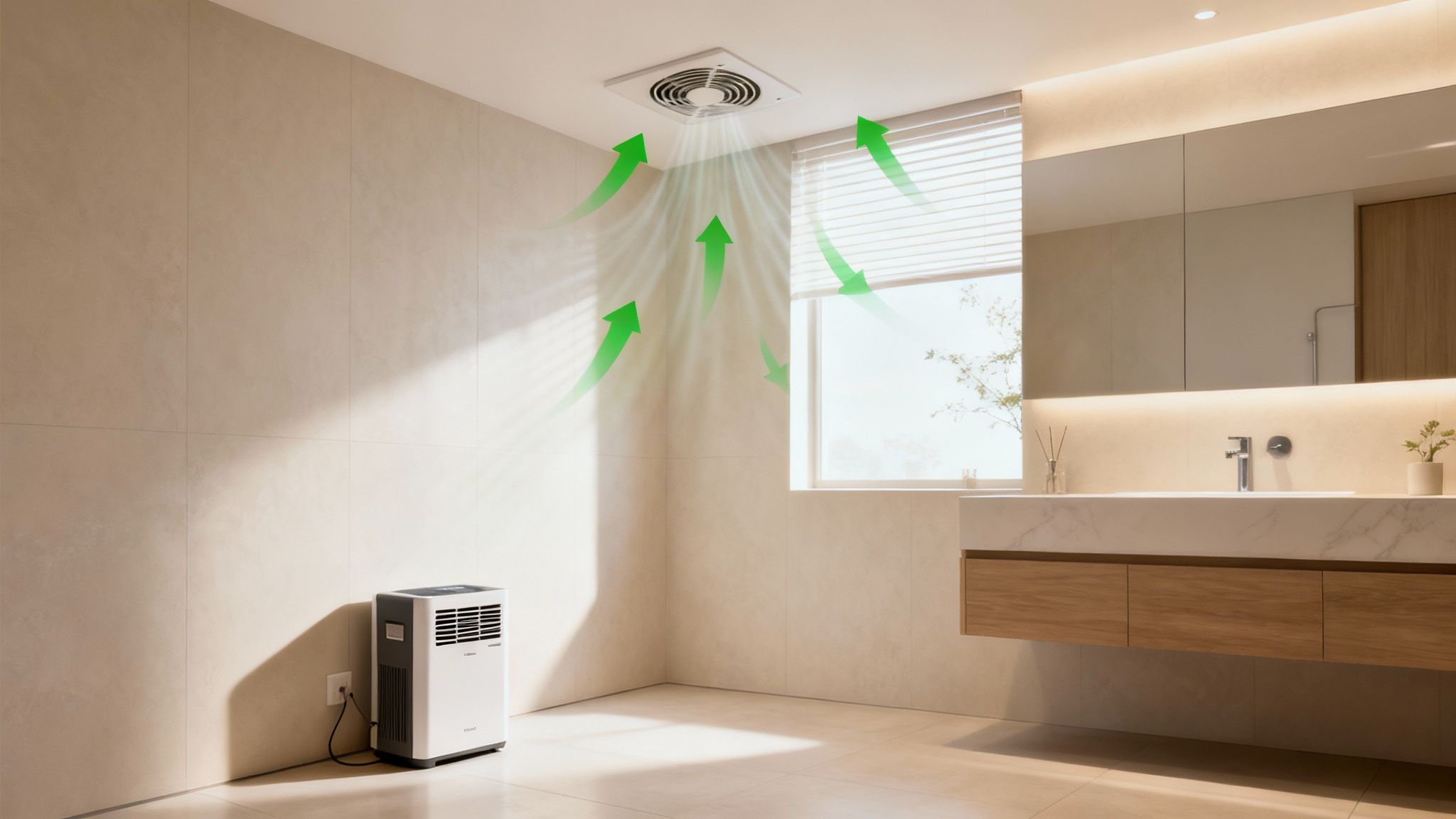
Preventing mold all boils down to one thing: controlling moisture. If you can manage humidity and stop water from getting in, you turn your home into a place where mold simply can’t survive.
Mastering Indoor Humidity Control
Southern California’s infamous “May Gray” and “June Gloom” can make indoor humidity skyrocket, rolling out the welcome mat for mold. Your best line of defense is keeping your home’s relative humidity between 30% and 50%.
Here’s how to do it:
- Use Dehumidifiers: Stick them in naturally damp spots like basements, crawlspaces, and bathrooms to literally pull moisture out of the air.
- Run Your Air Conditioner: Your AC is a secret weapon. It naturally dehumidifies while it cools, making it a huge help during those muggy coastal months.
- Ventilate, Ventilate, Ventilate: Always use exhaust fans in the kitchen when you cook and in the bathroom during and after showers. Let them run for a good 20-30 minutes afterward to push all that steamy air outside.
Routine Maintenance for a Drier Home
A few small, consistent maintenance tasks can stop the kind of catastrophic water damage that leads to massive mold problems. Just make these checks part of your yearly routine.
- Gutters and Downspouts: Keep them clear of leaves and gunk. This ensures rainwater flows away from your foundation instead of seeping into it.
- Roof Inspections: Check for busted or missing shingles, especially after a big storm. A small roof leak is a direct invitation for mold.
- Plumbing Checks: Every so often, take a peek under your sinks and around the toilets. A slow drip that goes unnoticed can soak drywall for months, creating a hidden mold factory.
This proactive mindset isn’t just a local trend. The global market for mold prevention services is projected to grow at a rate of 10.2% through 2033 as property owners realize that prevention costs far less than a full-blown remediation. By understanding and getting ahead of the unique challenges of our climate, you can protect your home for years to come.
Common Questions About Mold Testing and Removal
Even with a solid plan, it’s natural to have questions pop up when you’re dealing with mold. Homeowners often run into the same handful of concerns and myths. Let’s clear the air and tackle some of the most common ones you’ll face when you start searching for mold testing and removal near me.
Can I Just Use Bleach to Kill the Mold I See?
This is easily the biggest—and most dangerous—misconception out there. While bleach might seem like a quick fix for surface mold on non-porous tile or glass, the EPA actually advises against using it on materials like drywall or wood.
Here’s why: bleach is mostly water. When you spray it on a porous surface like drywall, the water soaks in deep, often missing the mold’s hidden root system (mycelia). Instead of killing it, you end up feeding the roots the very moisture they need to come roaring back, sometimes even stronger than before. Professionals use specialized, EPA-registered antimicrobial agents that are designed to kill mold at the root without adding more water to the problem.
Is Black Mold More Dangerous Than Other Types?
The term “black mold” gets a lot of media attention, usually referring to Stachybotrys chartarum, a species known for producing mycotoxins. It sounds terrifying, but the reality is a bit more complex.
Many types of mold can appear black, and molds of all different colors—green, white, even orange—can produce allergens and irritants that trigger health problems.
The safest bet is to treat any indoor mold growth as a potential health risk and get it handled by a professional, no matter what color it is. A certified inspector can tell you the species and concentration, but the simple truth is that any visible growth needs to be addressed right away.
How Long Does a Professional Mold Removal Project Take?
The timeline really depends on the scale of the problem. A small, straightforward job in a contained area, like a bathroom closet, can often be wrapped up in just 1-3 days.
But if you’re dealing with a bigger issue—say, contamination that has spread across multiple rooms, an entire basement, or a crawlspace—it could easily take a week or even longer. A trustworthy remediation company will always give you a detailed scope of work with a clear and realistic timeline before they start.
Do I Need to Leave My House During Mold Remediation?
Not always, but it depends on the scope of the work. For smaller, isolated jobs, you can often stay in your home. The crew will set up proper containment with plastic sheeting and negative air pressure to keep the work area sealed off from the rest of the house.
However, if it’s a large-scale project that impacts your HVAC system or essential living areas like the kitchen or bedrooms, it’s much safer (and more practical) to stay somewhere else. This keeps your family safe from airborne spores and lets the team work without interruptions. Your project manager will walk you through the specifics and recommend the safest approach for your situation.
If you’re facing a mold issue and need clear answers, don’t wait. The experts at Onsite Pro Restoration are here to provide a professional assessment and create a safe, effective plan to restore your home. Contact us 24/7 for immediate assistance. https://onsitepro.org


